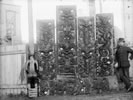New Zealand Exhibition, Dunedin, 1865
The London exhibitions of 1851 and 1862 inspired Dunedin to host the country’s first domestic display. Following a suggestion by Anglican leaders, Dunedin promoters saw an exhibition as a way of turning gold-rush wealth into long-term wealth. With equal grants of £4,000 from the central and provincial governments, the exhibition became an international event, with displays from Canada, France, Belgium, the Netherlands, Germany, Austria, Great Britain, Fiji and the Australian colonies.
Bad start
The New Zealand Exhibition of 1865 did not start promisingly. The boat bringing the British exhibits had an unusually slow passage to New Zealand, and did not arrive on time. Governor George Grey, who was due to open it, was preoccupied with fighting in the North Island and failed to show, and indeed never subsequently visited. This created resentment, although he did send specimens of ferns and mosses.
The exhibition pioneered many features later used in international exhibitions – a gilded obelisk representing gold exports; maps and geology displays by the then provincial geologist, James Hector; stuffed native birds from ornithologist Walter Buller; collections of woods, flax and wool; paintings by landscape artists and a good collection of Māori artefacts intended to show off ‘one of the finest and most intelligent of aboriginal races’.1
The exhibition attracted 31,250 visitors.
Early 1880s exhibitions
The 1880s saw a flurry of local exhibitions. They were intended to promote local industry just as A & P (agricultural and pastoral) shows were promoting agriculture at this time.
The revival was started by Canterbury businessmen who, in 1879, formed the Canterbury Industrial Association to encourage local industry and advocate for protection. They decided an exhibition would aid their cause. Held in the Christchurch drill shed in 1880, it was intended to run for only three days, but was extended to six.
Two years later two promoters, Jules Joubert and Richard Twopenny, who had organised money-making exhibitions in Adelaide and Perth, arrived in Christchurch with similar ambitions. The Industrial Association was supportive (although some were less keen when the exhibition included competing goods from European countries, America, China, Japan, India and the Australian colonies). The New Zealand International Exhibition, as it was called, ran for 14 weeks in Hagley Park; but the promoters’ hopes were dashed as the event lost money, even though 226,300 visited. There was a ladies court, with 270 handcrafts; a Māori court with flax work, carvings and pounamu; and an art gallery, a concert room and a fernery.
There were also local industrial exhibitions in Wellington, Dunedin and Ashburton in 1881, and Christchurch again in 1883–84.
New Zealand Industrial Exhibition, Wellington, 1885
Impressed with these efforts the Stout-Vogel government decided to hold an exhibition in Wellington in 1885. The government invested £9,000 in the event, which was held in a large building on Lambton Quay. The exhibition included art displays and concerts, and ran for three months.
New Zealand and South Seas Exhibition, 1889–90
The New Zealand and South Seas Exhibition was held on Anderson’s Bay Road in Dunedin to commemorate 50 years of British sovereignty over the colony. Once more promoters Jules Joubert and Richard Twopenny were the leading officials, and the private company set up for the exhibition received a £10,000 government subsidy. There was a modest profit.
The exhibition was international in scope, with exhibits sent from some European countries, Australia, Japan and several Pacific Islands. Many displays were brought over from the 1888 Melbourne exhibition. Although industrial and mineral exhibits were significant, there were also government courts on minerals, education and tourism. There was a concert hall and, for the first time in New Zealand, an amusement zone.
The Māori court, organised by collector Thomas Hocken, included displays from Pākehā collectors including John White, Walter Buller and Augustus Hamilton. But there was no Māori involvement.
Inspiring art
A major aspect of the 1889 exhibition in Dunedin was the art gallery. It displayed an impressive collection of 1,500 works, highlighted by the etchings and engravings of European artists such as Albrecht Dürer, Andrea Mantegna and Rembrandt van Rijn from Bishop D. G. Monrad’s collection. The positive public response to the exhibition fuelled moves to expand and give a new home to the Dunedin Art Gallery, founded by W. M. Hodgkins in 1884. Artworks were purchased and part of the exhibition buildings were added to Otago Museum as an expanded home for the gallery.
Other exhibitions
The exhibition to mark the colony’s jubilee (50th anniversary) was followed by industrial exhibitions to mark provincial jubilees – New Plymouth in 1891 for Taranaki’s jubilee; Dunedin in 1898 for Otago’s; and Christchurch in 1900 for Canterbury’s. These exhibitions were primarily designed to show off local manufactured goods. This was also true of several other events during the decade – a Christchurch Industrial Exhibition in 1895, once more promoted by the Industrial Association, a Wellington Industrial Exhibition in 1896 and, not to be outdone by the southern cities, Auckland held an Industrial and Mining Exhibition in 1898.









